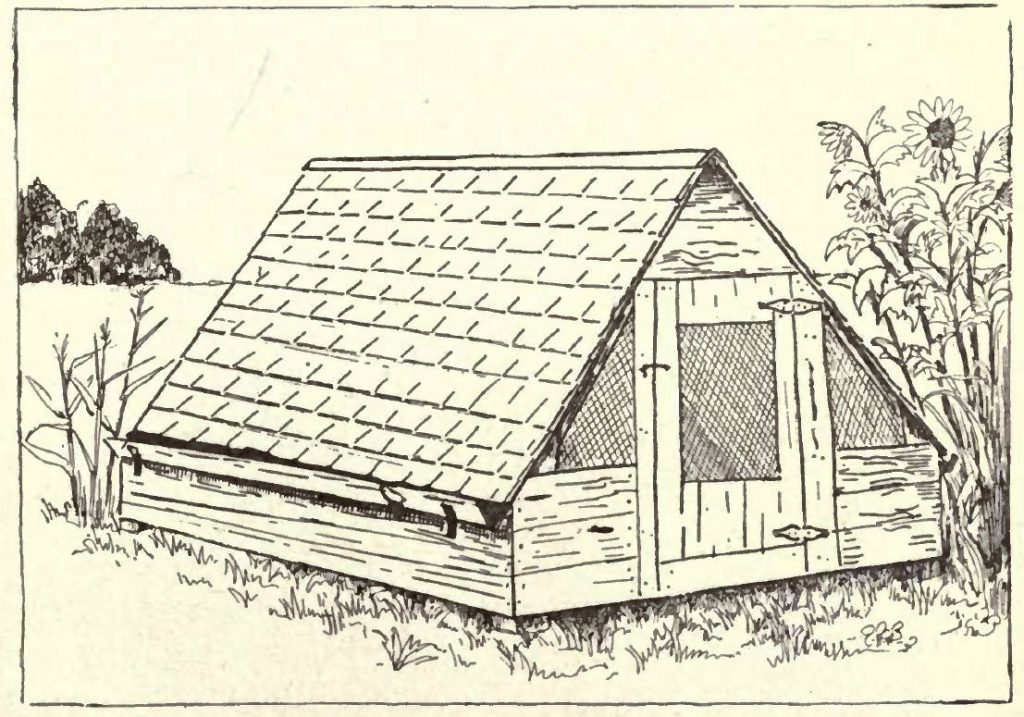
Colony house to accommodate from 12 to 25 fowls. This house is eight feet square on the ground and eight feet from floor to apex of roof. There is no frame, but the roof boards are nailed to the ridgepole and to plank baseboards.
Much of a man’s success or failure in the poultry business will depend upon the location and construction of his plant.
Where hens are kept in small numbers and given free range, they do well almost anywhere; but where they are kept in large numbers and in confinement, they must have as favorable conditions as possible or they will prove a source of loss and not of profit to their owner.
The best location for a poultry plant is on sandy soil, where there is a gentle slope to the south or southeast. If there is a wind-break of some kind on the north and northwest the location becomes ideal. Such a location, however, is hard to find nor is it indispensable. Poultry can be kept on almost any soil, provided it is not saturated with water for a considerable portion of the year.
Even a clay soil has its advantages ; it produces a luxuriant growth of grass which not only provides the fowls with forage, but which also by its roots takes up the excrement which otherwise might contaminate the ground.
Before the poultryman drives a nail or does a stroke of work he should carefully consider the possibilities of his situation, and lay out his prospective plant in his mind. If he is to build largely at once it might pay him to consult an expert.
But if he is to build only one small house, he should build it with reference to others that he may put up in future years. So I say, have a plan. The details may be filled in at the poultryman’s convenience or they may never be filled in. But if the man lives and his business grows the time will come when he will thank his stars that he was wise and far-seeing enough to have a plan at the very start, and not have to waste time and money moving buildings about or in tearing them down and replacing them with others.
The Colony Poultry House Plan.
There are three methods of keeping hens in large numbers. The first of these is the colony plan. The principle of the colony plan is that of keeping hens in small segregated houses twenty-five to fifty hens in a house.
These houses are scattered at regular intervals over the farm, and are visited two or three times a day by an attendant. The hens are given free range. It has been found that when houses are one hundred yards apart, or even less, flocks will not mingle, but each flock will keep in the neighborhood of its own house.
This plan has its advantages. It is inexpensive. The houses may be of the cheapest kind. No yards are required. The hens at certain seasons of the year pick up a good deal of their living. If the houses are located in an orchard the hens fertilize the ground around the trees and eat the wormy fruit.
No dangerous disease is likely to break out among hens kept in colonies. But on the other hand the plan has serious drawbacks. Even in pleasant weather it requires a good deal of time each day to visit the scattered flocks; but in winter, when a blizzard is raging, to make the rounds of the houses is an experience calculated to make one appreciate the perils and hardships of a Polar expedition.
Then, too, these isolated, detached houses are shining marks for thieves; and unless the neighborhood is exceptionally honest, the poultryman may wake up some morning to discover that two or three hundred of his fowls have vanished.
This article is extracted from 200 Eggs a Year Per Hen: How to Get Them by Edgar Wallace first published in 1899.
Poultry Housing in the Victorian Era
- Most Palatial Poultry House Ever
- The Colony Poultry House – Low Cost Chicken Coop
- Three Dollar Poultry Houses from Recycled Packing Cases

